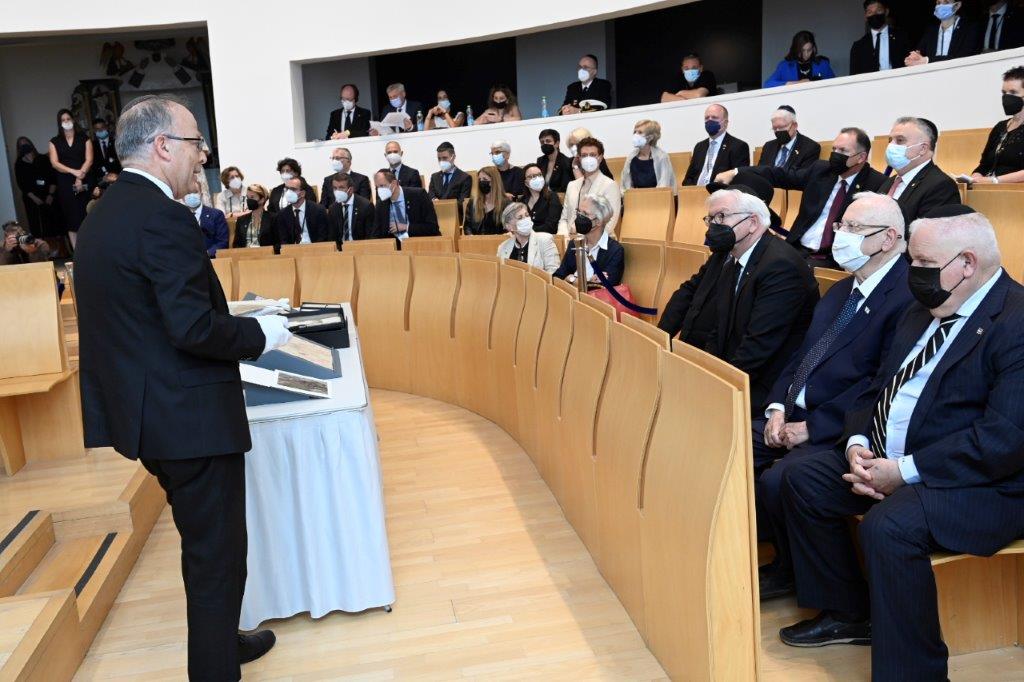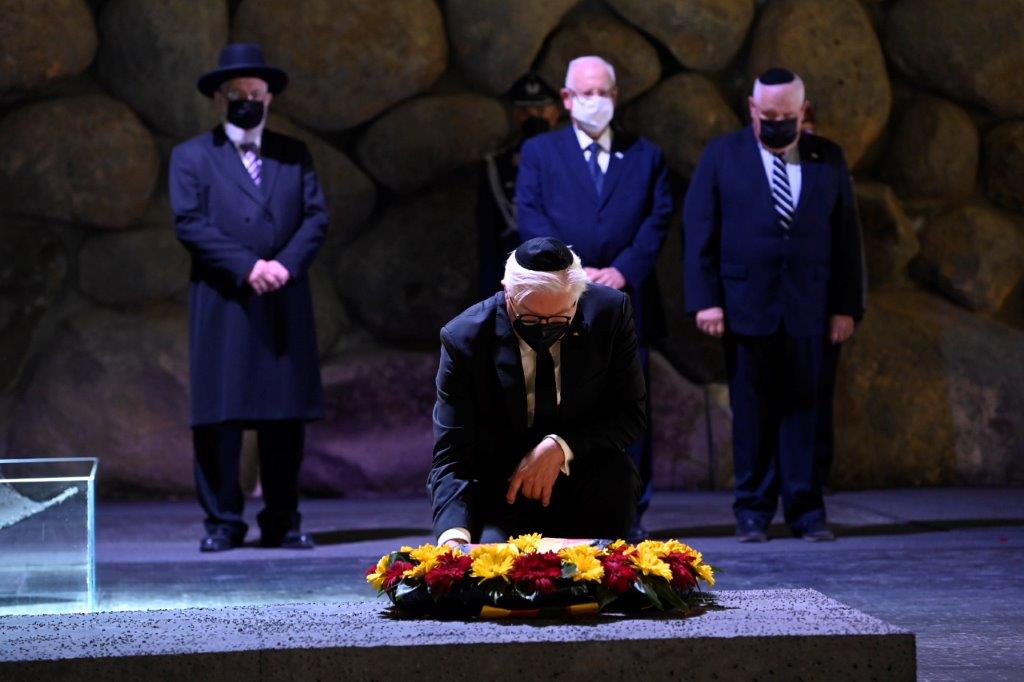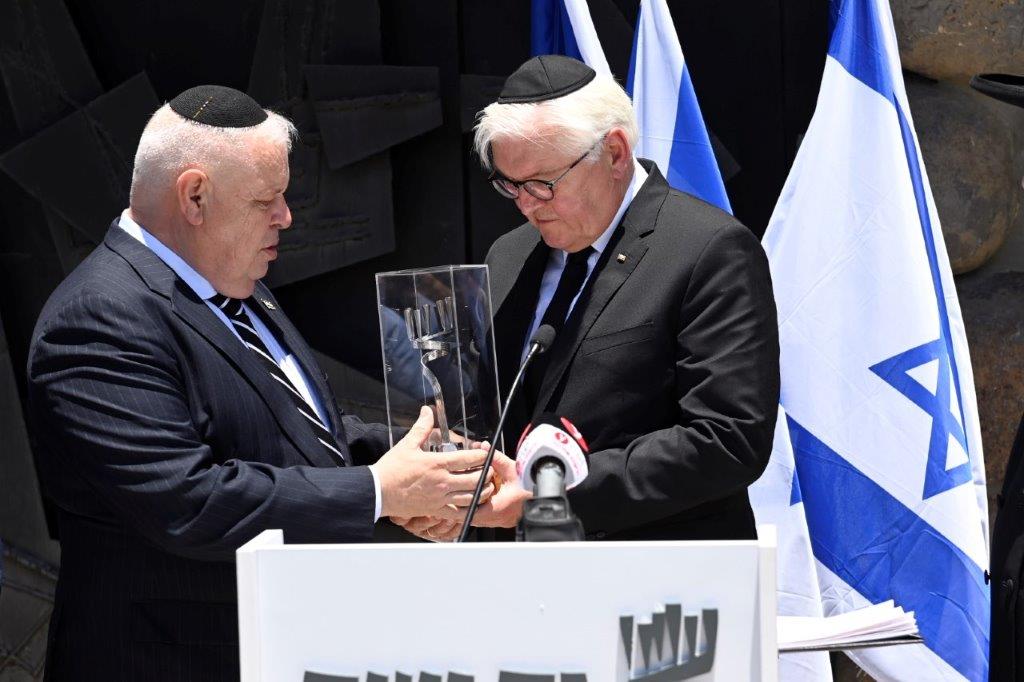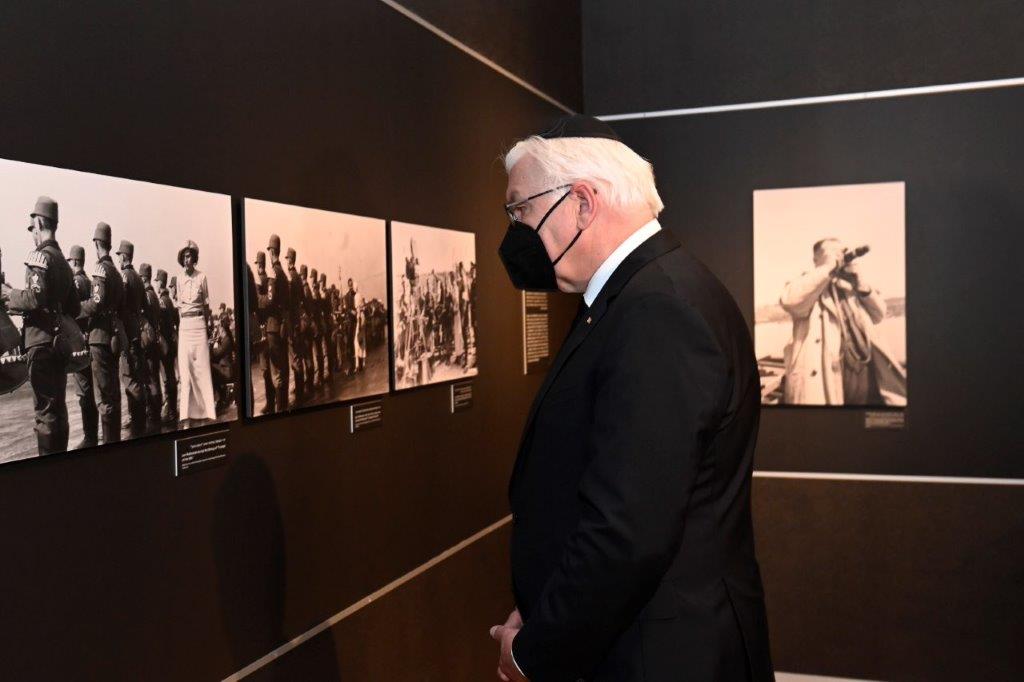(L-R) Yad Vashem Council Chairman Israel Meir Lau, President of Israel Reuven Rivlin, President of Germany Frank-Walter Steinmeier and Acting Yad Vashem Chairman Ronen Plot tour the "Flashes of Memory: Photography during the Holocaust" exhibition
For more pictures click here
01 July 2021
Today, President of the Federal Republic of Germany H.E. Dr. Frank-Walter Steinmeier visited Yad Vashem, the World Holocaust Remembrance Center. He was joined by Israel's President H.E. Mr. Reuven "Ruvi" Rivlin, Chairman of the Yad Vashem Council Rabbi Israel Meir Lau and Acting Chairman of Yad Vashem Ronen Plot. The Presidents and their delegations toured the "Flashes of Memory: Photography during the Holocaust" exhibition, were shown two rare diaries written during the Holocaust, participated in a memorial ceremony in the Hall of Remembrance, signed the Yad Vashem Guest Book. At the conclusion of the visit President Steinmeier offered the following remarks:
The unspeakable suffering that was caused in Germany's name fills us with pain and shame. We will keep the memory of this alive for the sake of those who were murdered and for the sake of future generations. It is in light of Germany's responsibility for the Shoah that we solemnly promise, "Never Again."
Acting Yad Vashem Chairman Ronen Plot said;:
I thank the President of Germany for visiting Yad Vashem for the third time during his tenure. This shows the significance Germany places on commemorating the Holocaust and transmitting its meanings to future generations.
Yad Vashem International Relations Division Director Dr. Haim Gertner, formerly Director of the Yad Vashem Archives, presented the two diaries to the Presidents in the Synagogue located on the Mount of Remembrance. These rare manuscripts, written by Jews during the Holocaust, remain among the few authentic documents that managed to survive the war and continue to serve as everlasting witnesses to the unspeakable atrocities that befell Jewish men, women and children at the hands of the Nazis and their collaborators.
Alfred Zielony from Warsaw was forced to live in the infamous Warsaw ghetto. While incarcerated, Alfred began recording his experiences in a diary. Throughout the war, he kept the diary with him, even when it was damaged by fire and water. He survived the war in hiding. After the war, he married his non-Jewish rescuer, and they lived in Poland until he died in 1956. In 2006, Alfred Zielony's relatives donated the diary, which more resembled a ball of paper, to Yad Vashem. Unsure of its content, the preservation experts at Yad Vashem began a painstaking and intensive restoration process, which eventually turned the garbled clump of damaged papers into a legible diary. Yad Vashem experts, with the assistance of Alfred's son, Wlodek are still working on restoring and deciphering the content of this diary.
The second diary presented by Dr. Gertner was written by a 14-year-old girl named Rywka Lipszyc from Lodz. Rywka recorded her experiences over a course of 11 months while incarcerated in the Lodz ghetto. Even after she was deported to the Auschwitz-Birkenau concentration and extermination camp, Rywka kept her precious diary close to her. Days before Auschwitz-Birkenau was liberated by the Red Army, Rywka was forced together with many other prisoners on a death march. Upon arrival at Bergen-Belsen, Rywka was dangerously ill. Despite being liberated by Allied forces in April 1945, she died in hospital several months after the end of the war. The diary, written in Polish – was found in January 1945 among the ashes near one of the crematorium in Auschwitz-Birkenau by Dr. Zinaida Berezovskaya, one of the physicians of the liberating Red Army. She kept the diary with her, where it remained untouched for over a half a century.
In 2008, Berezovskaya granddaughter discovered her diary among her family's belongings and began to try to locate the owners. The diary was eventually donated to Yad Vashem. Thanks to the Page of Testimony stored in Yad Vashem's Archives, researchers were able to locate Mina Boier and Esther Burstein, Rywka's cousins, who was with Rywka on their ill-fated journey from Lodz to Auschwitz. Thankfully they survived the horrors of the Holocaust and immigrated to Israel. In 1955 Rywka's cousins filled out a Page of Testimony in her memory. For years, both Mina and Esther was unaware that Rywka's diary survived the war. In 2012, Mina and Esther werereunited with Rywka's diary. At the time, they remarked how this "awakened painful memories of our wartime experiences, but it also provided the strength to share the rich legacy of our family's faith expressed so poignantly in its pages." This remarkable document is now used to tell the personal story of Rywka Lipszyc, as well as the greater narrative of the Holocaust to many millions of people.
"I am just a tiny spot, even under a microscope I would be very hard to see – but I can laugh at the whole world because I am a Jew. I am poor and in the ghetto, I do not know what will happen to me tomorrow, and yet I can laugh at the whole world because I have something very strong supporting me – my faith." Excerpt from Rywka's Diary
Both of these extraordinary items will be housed in the new Collections Center currently being built at Yad Vashem as part of the Moshal Shoah Legacy Campus, which received support, among others, from the Federal Republic of Germany. Yad Vashem houses the world's largest collections of Holocaust-related documentation, photographs, artifacts and artwork.
The evening before President Steinmeier's moving visit to Yad Vashem, he presented Yad Vashem Chairman Emeritus Avner Shalev with the Order of Merit of the Federal Republic of Germany, Germany's highest tribute given to individuals, at a ceremony in Tel Aviv. Three other notable Israeli figures also received this prestigious award: Holocaust survivor Regina Steinitz, author David Grossman and artist Michal Rovner.



Yad Vashem


Yad Vashem

Embassy of Germany

Yad Vashem







